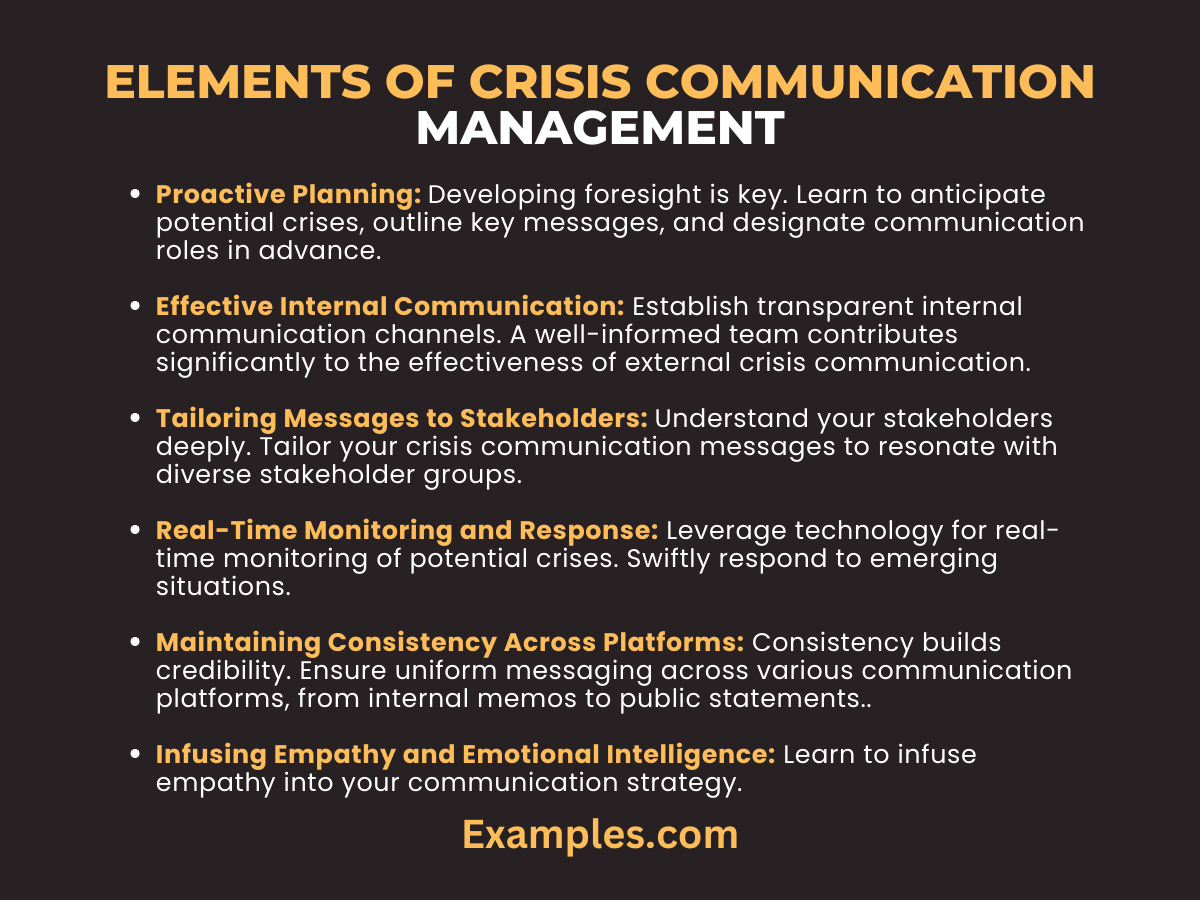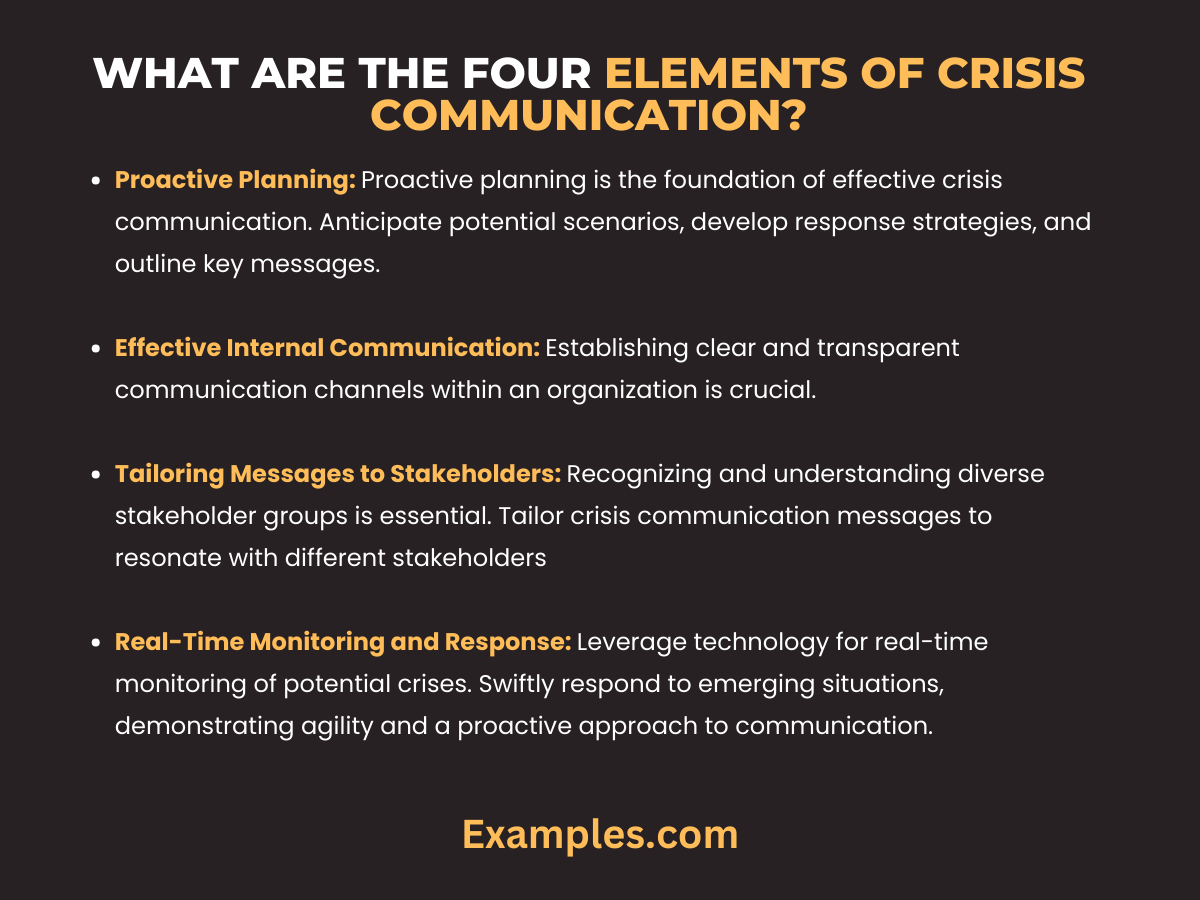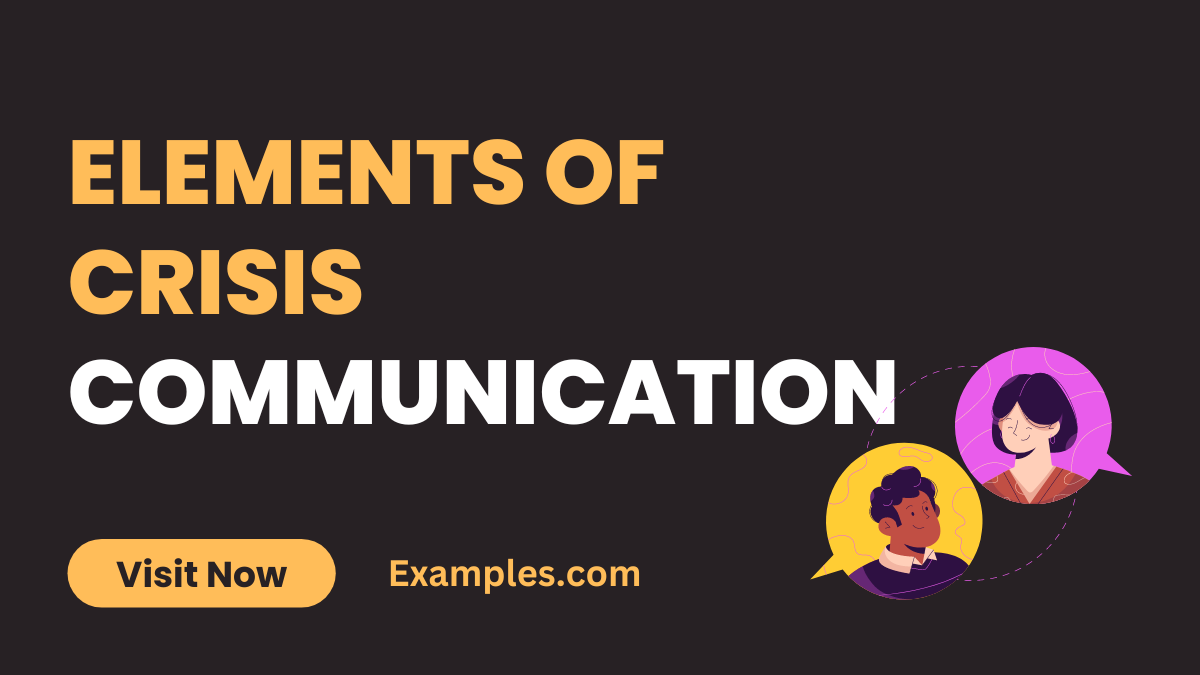19+ Elements of Crisis Communication Examples
Embark on a journey to unravel the core elements of crisis communication, a strategic playbook for navigating turbulent waters. This guide provides a comprehensive definition, insightful historical context, and actionable tips. Explore real-world examples, learn the art of crisis management, and discover invaluable tips to fortify your communication arsenal. Whether you’re a novice or a seasoned professional, master the essential skills needed to adeptly handle crises and emerge stronger.
What is Crisis Communication?

Crisis communication is the strategic process of conveying accurate and timely information during challenging situations to maintain trust, manage reputation, and guide stakeholders through uncertainty. It involves transparent messaging, rapid response, and empathy to address the impact of crises, be it in healthcare, business, or other realms. This intentional communication approach aims to mitigate damage, foster resilience, and strengthen relationships amid unexpected challenges.
20 Examples of Elements of Crisis Communication

The elements of crisis communication encompass various strategies, including proactive planning, effective internal communication, stakeholder-specific messaging, and rapid response tactics. Employing empathy, consistency, and real-time monitoring, these elements guide organizations through crises while maintaining transparency and credibility.
- Proactive Planning: Apple’s swift recall strategies for product defects, demonstrating advanced preparation.
- Internal Communication: Google’s open channels, ensuring a well-informed team during crises.
- Stakeholder-Specific Messaging: Amazon’s tailored customer updates during supply chain disruptions.
- Rapid Response Tactics: Tesla’s quick public statements post-accidents, ensuring immediate clarification.
- Empathy in Communication: Patagonia’s heartfelt messages during environmental crises, resonating with stakeholders.
- Consistent Messaging: Coca-Cola’s uniform crisis statements across platforms, maintaining credibility.
- Real-Time Monitoring: Facebook’s vigilant monitoring for swift crisis resolution in data breaches.
- Transparent Communication: Airbnb’s transparent guest safety guidelines during unforeseen events.
- Factual Accuracy: Microsoft’s verified crisis information shared with stakeholders, ensuring accuracy.
- Post-Crisis Evaluation: Boeing’s comprehensive post-737 Max crisis assessment for future improvements.
- Instructional Communication: Walmart’s detailed recall instructions to address product safety issues.
- Adjustment Communication: Netflix’s adaptive subscription model during content-related crises.
- Reputation Management: Toyota’s consistent image repair strategy after quality issues.
- External Communication: Disney’s cohesive public announcements during theme park incidents.
- Social Media Management: Nike’s adept handling of social media criticisms, maintaining brand image.
- Instructional Communication: Spotify’s user guidelines during system outages for smoother navigation.
- Post-Crisis Communication: Starbucks’ transparent recovery plans after store controversies.
- Media Management: Uber’s media engagement strategy to address driver safety concerns.
- Crisis Communication in Healthcare: Mayo Clinic’s precise crisis communications for patient reassurance.
- Crisis Communication in Higher Education: Harvard University’s prompt crisis management during administrative crises.
Elements Of Crisis Communication Management

In navigating crises, mastering the elements of crisis communication management is crucial. Sharpening your communication skills is the bedrock of successful crisis response.
1. Proactive Planning: Developing foresight is key. Learn to anticipate potential crises, outline key messages, and designate communication roles in advance. Proactive planning empowers you to tackle crises with confidence.
2. Effective Internal Communication: Establish transparent internal communication channels. A well-informed team contributes significantly to the effectiveness of external crisis communication. Strengthen your communication skills within the organization.
3. Tailoring Messages to Stakeholders: Understand your stakeholders deeply. Tailor your crisis communication messages to resonate with diverse stakeholder groups, addressing their specific concerns and expectations. Hone your ability to communicate with precision.
4. Real-Time Monitoring and Response: Leverage technology for real-time monitoring of potential crises. Swiftly respond to emerging situations, showcasing agility and a proactive approach to communication. Learn to stay ahead with real-time communication.
5. Maintaining Consistency Across Platforms: Consistency builds credibility. Ensure uniform messaging across various communication platforms, from internal memos to public statements. Strengthen your skills in maintaining consistency during high-pressure situations.
6. Infusing Empathy and Emotional Intelligence: Learn to infuse empathy into your communication strategy. Understand the emotional impact of a crisis on stakeholders and respond with genuine concern and compassion. Elevate your crisis communication skills with emotional intelligence.
Elements Of A Crisis Communication Plan
In the realm of crisis management, a well-crafted communication plan is paramount. Successful crisis communication relies on a strategic approach that encompasses various elements.
- Proactive Planning: Develop a robust plan in advance, anticipating potential crises, outlining key messages, and assigning communication roles.
- Crisis Communication Team: Formulate a dedicated team with individuals possessing strong communication skills, ensuring they undergo regular training to stay prepared.
- Internal Communication Channels: Foster open and transparent internal communication channels to ensure an informed team during crises.
- Stakeholder Analysis: Identify and understand key stakeholders, tailoring communication messages to address their concerns and expectations.
- Real-Time Monitoring and Response: Utilize technology for real-time monitoring of potential crises, allowing for swift and proactive communication.
- Consistent Messaging: Ensure consistency in messaging across various communication platforms, building credibility during a crisis.
- Empathy and Emotional Intelligence: Infuse empathy into the communication strategy, understanding the emotional impact of a crisis on stakeholders.
- Clear and Concise Messaging: Practice clear and concise communication, avoiding jargon and delivering straightforward messages.
- Social Media Management: Develop social media guidelines for crisis situations, efficiently managing and responding to online conversations.
- Media Relations Mastery: Train key personnel for effective media interactions, navigating inquiries with poise and providing accurate information.
Elements Of Crisis Communications Tips
In navigating the complex landscape of crisis communications, mastering essential tips is paramount. These strategies, informed by effective communication skills, empower organizations to weather storms while preserving reputation and stakeholder trust.
- Proactive Planning: Begin with meticulous planning, anticipating potential crises. Establish a proactive crisis communication plan to guide responses.
- Effective Internal Communication: Foster a culture of open, transparent internal communication. A well-informed team is an invaluable asset during crises.
- Tailoring Messages to Stakeholders: Identify key stakeholders and tailor crisis messages to address their unique concerns and expectations.
- Rapid Response Tactics: Develop swift response strategies based on the severity of the crisis. Timeliness is crucial in maintaining stakeholder trust.
- Empathy and Emotional Intelligence: Infuse empathy into communications. Understand the emotional impact of a crisis on stakeholders and respond with compassion.
- Clear and Consistent Messaging: Practice clear and consistent communication across all platforms. Clarity builds credibility, even in challenging times.
- Real-Time Monitoring and Response: Leverage technology for real-time monitoring of potential crises. Swiftly respond to emerging situations, demonstrating agility.
- Media Relations Mastery: Train key personnel for effective media interactions. Navigate media inquiries with poise, providing accurate information while safeguarding reputation.
- Social Media Management: Develop and implement social media guidelines for crisis situations. Efficiently manage and respond to social media conversations.
- Post-Crisis Evaluation: Conduct a thorough evaluation post-crisis. Analyze the effectiveness of communication strategies and identify areas for improvement.
What Are The Four Elements Of Crisis Communication?

In the realm of crisis communication, mastering the four essential elements is crucial for effective response and reputation management.
1. Proactive Planning: Proactive planning is the foundation of effective crisis communication. Anticipate potential scenarios, develop response strategies, and outline key messages. This element ensures that organizations are well-prepared to navigate crises with agility and responsiveness.
2. Effective Internal Communication: Establishing clear and transparent communication channels within an organization is crucial. A well-informed internal team becomes a valuable asset during a crisis, contributing to the overall effectiveness of external communication.
3. Tailoring Messages to Stakeholders: Recognizing and understanding diverse stakeholder groups is essential. Tailor crisis communication messages to resonate with different stakeholders, addressing their specific concerns and expectations. This element enhances the relevance and impact of the communication.
4. Real-Time Monitoring and Response: Leverage technology for real-time monitoring of potential crises. Swiftly respond to emerging situations, demonstrating agility and a proactive approach to communication. This element ensures that organizations stay ahead in managing and mitigating crises effectively.
What Is The Purpose Of A Crisis Communication Plan
In the realm of effective crisis management, the purpose of a meticulously designed crisis communication plan is multifaceted:
1. Anticipating Potential Crises: A primary objective involves pre-emptive identification and anticipation of potential crises that an organization might encounter. This proactive approach allows for the creation of tailored response strategies.
2. Rapid Response and Preparedness: The core purpose lies in facilitating rapid and effective responses to mitigate the impact of a crisis. It ensures the readiness of the organization, enabling timely and decisive actions.
3. Minimizing Reputational Damage: Another crucial aim is to mitigate reputational damage by deploying timely and well-orchestrated communication strategies. This includes controlling the narrative and fostering trust among stakeholders.
4. Stakeholder Management: The plan focuses on managing various stakeholders by addressing their concerns, disseminating accurate information, and maintaining transparent communication channels.
5. Coordination and Consistency: Ensuring coordination among different departments and stakeholders is pivotal. Consistent messaging across all communication channels aids in preventing confusion and misinformation.
6. Building Organizational Resilience: Beyond immediate crisis management, a robust communication plan aims to fortify the organization’s resilience. It facilitates learning from crises to improve future response strategies.
7. Regulatory and Legal Compliance: Adherence to legal and regulatory requirements is a vital aspect. The plan ensures that communications meet compliance standards, averting potential legal repercussions.
8. Enhancing Public Image: Lastly, a crisis communication plan seeks to bolster the organization’s public image. This includes strategies to positively position the company, even during challenging times.
In mastering the art of crisis communication, understanding and employing the essential elements are paramount. From proactive planning to transparent communication, each facet plays a crucial role. By studying real-world examples, we glean valuable insights into effective crisis communication, forging a comprehensive guide for navigating the complexities of unpredictable situations. These principles ensure organizations not only weather crises but emerge stronger and more resilient.
Understanding the nuanced facets of crisis communication is pivotal. Employing proactive planning, transparent communication, and tailored messaging for stakeholders aids in effective crisis resolution. Learning from real-world examples by industry giants, embracing empathy, and consistently evaluating strategies ensure a robust framework. These elements form the bedrock for managing crises, fostering trust, and fortifying organizational resilience in an ever-evolving landscape.



